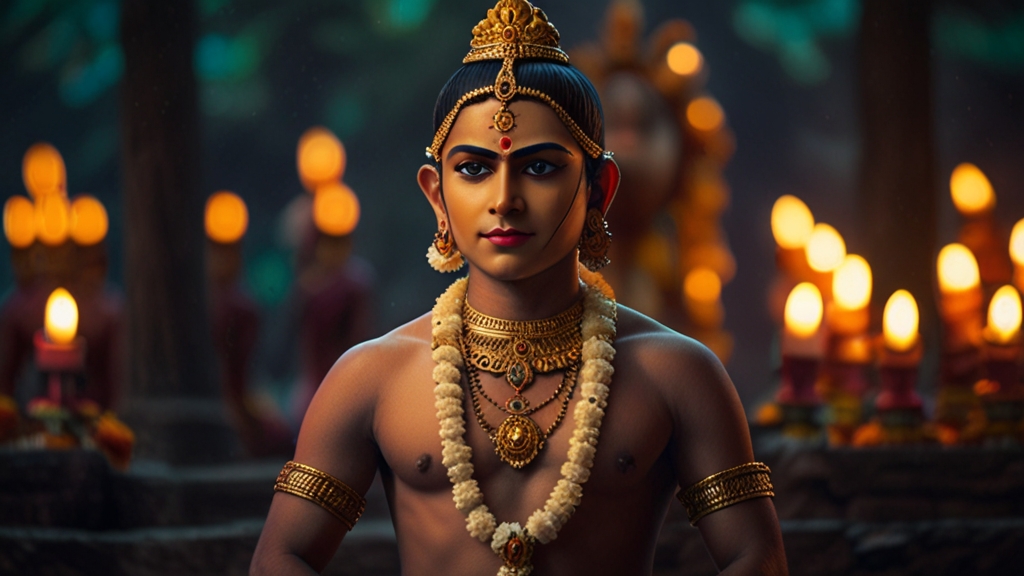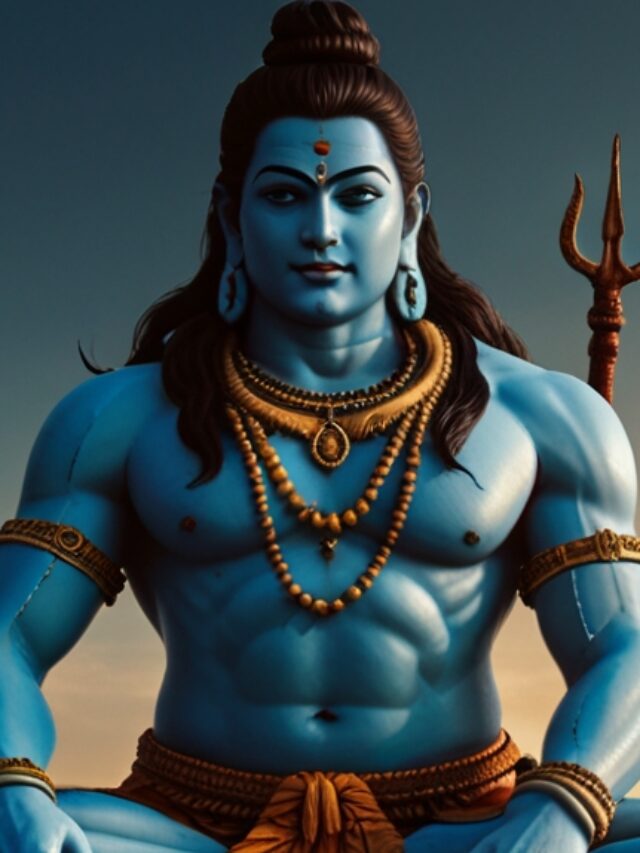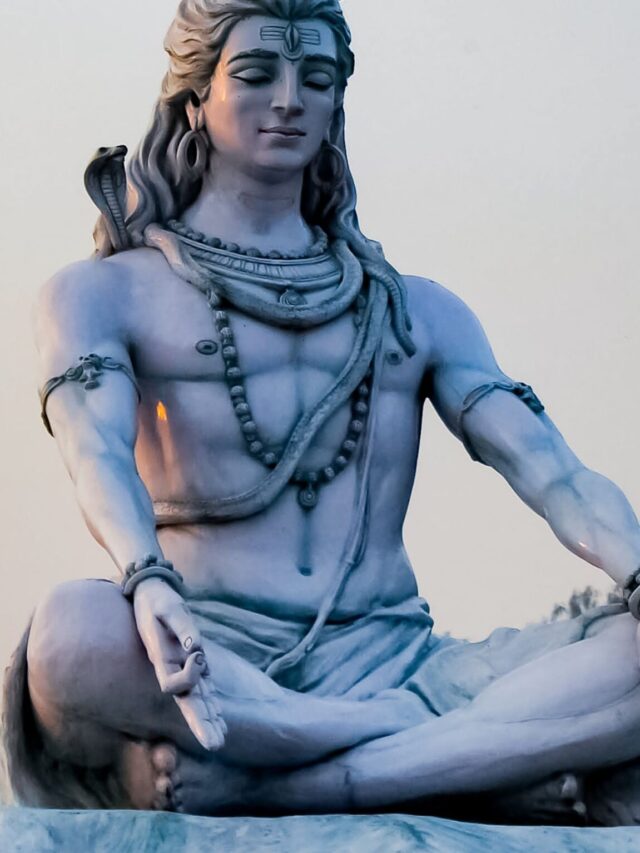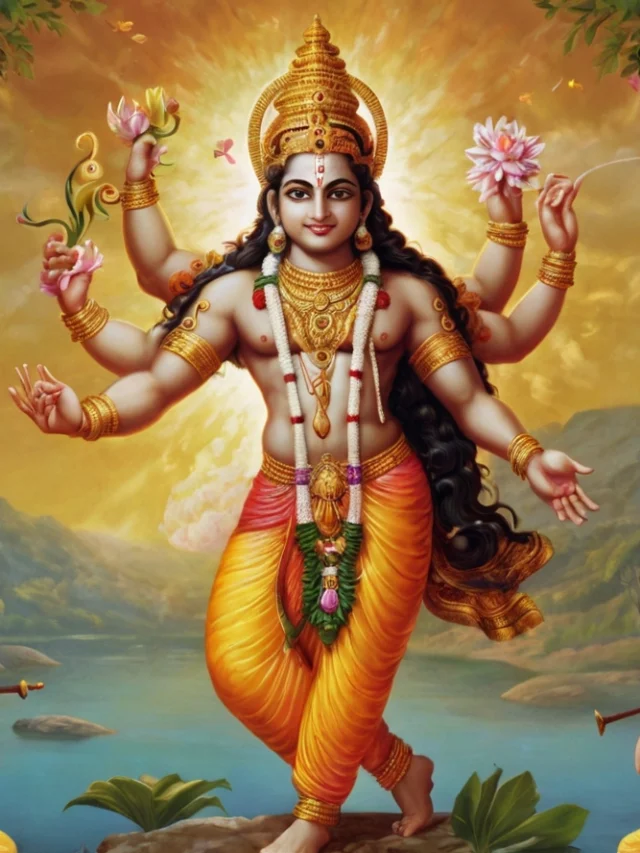The Ramayana: Epic Journey of Dharma and Devotion, an ancient Hindu epic by Valmiki, narrates the life of Lord Rama, highlighting themes of duty, righteousness, and devotion through his adventures and trials. This timeless tale continues to inspire with its portrayal of the triumph of good over evil.

Introduction
The Ramayana is one of the most important epics in Hindu literature, attributed to the sage Valmiki. Composed in Sanskrit, it narrates the life and adventures of Lord Rama, an avatar of the god Vishnu. The epic, with its profound themes of duty, righteousness, and devotion, has been a cornerstone of Indian culture and spirituality for millennia.
Structure of the Ramayana
The Ramayana is traditionally divided into seven books (Kandas), each detailing different phases of Rama’s life:
- Bala Kanda: The book of Rama’s childhood, his divine birth, early exploits, and marriage to Sita.
- Ayodhya Kanda: The events in the kingdom of Ayodhya, including Rama’s preparation for coronation, his exile, and the departure to the forest.
- Aranya Kanda: Rama’s life in the forest during his exile, the abduction of Sita by Ravana, and the search for her.
- Kishkindha Kanda: The alliance with the monkey king Sugriva, and the efforts to locate Sita.
- Sundara Kanda: Hanuman’s journey to Lanka, his search for Sita, and his return to Rama with news of her whereabouts.
- Yuddha Kanda: The battle in Lanka, the defeat of Ravana, and the rescue of Sita.
- Uttara Kanda: Rama’s return to Ayodhya, his coronation, and the challenges he faces during his rule.

Balkand of Ramayan:The Birth of Lord Rama
Introduction
Lord Rama, the central figure of the Hindu epic Ramayana, is one of the most venerated deities in Hinduism. His birth story, rich with divine intervention and symbolism, is celebrated as an event that heralded the arrival of righteousness and virtue on earth.
The Context of Rama’s Birth
The story begins in the ancient kingdom of Ayodhya, ruled by King Dasharatha, a just and powerful monarch of the Solar dynasty (Suryavansha). Despite his prosperity and virtue, Dasharatha was deeply distressed because he had no heirs to carry on his legacy and maintain the dharma (cosmic law and order).
The Performance of Putrakameshti Yajna
 Performance of yajna for birth of Rama
Performance of yajna for birth of Rama
To seek a solution, Dasharatha consulted his royal priests and sages, who advised him to perform the Putrakameshti Yajna, a sacred fire ritual aimed at obtaining progeny. The ritual was conducted with utmost devotion by the sage Rishyasringa, known for his spiritual prowess.
The Divine Blessing
As the yajna concluded, Agni, the god of fire, emerged from the sacrificial flames bearing a golden vessel containing divine nectar, known as payasam. He instructed Dasharatha to distribute the nectar among his three queens:
- Kausalya: The eldest queen and mother of Rama.
- Kaikeyi: The second queen and mother of Bharata.
- Sumitra: The youngest queen and mother of the twins, Lakshmana and Shatrughna.
Dasharatha followed Agni’s instructions, and soon after, the queens became pregnant.
The Birth of the Divine Princes
On the ninth day of the Chaitra month (March-April), during the auspicious period known as Navami Tithi, under the Punarvasu Nakshatra (a constellation), and at the noon hour, Queen Kausalya gave birth to Rama. His birth was marked by celestial signs and divine phenomena, signaling the arrival of a divine being destined to restore dharma. The other queens also gave birth: Kaikeyi to Bharata and Sumitra to the twins, Lakshmana and Shatrughna.
Significance and Celebrations
Rama’s birth is celebrated as Ram Navami, a major Hindu festival that commemorates the descent of Vishnu in his Rama avatar. Devotees observe this day with great reverence, engaging in fasting, singing bhajans (devotional songs), reciting passages from the Ramayana, and participating in elaborate processions and rituals.
The Symbolism of Rama’s Birth
Rama’s birth is more than a historical or mythological event; it is symbolic of the perpetual struggle and triumph of good over evil. His arrival represents hope and the assurance that divine forces will intervene to uphold righteousness. The conditions surrounding his birth—cosmic alignments, divine nectar, and the piousness of Dasharatha’s yajna—underscore the profound belief in dharma and the importance of divine will in human affairs.
Conclusion
The birth of Lord Rama is a cornerstone of Hindu tradition and spirituality, embodying the ideals of virtue, duty, and divine intervention. His life and deeds, beginning with his miraculous birth, continue to inspire millions, guiding them towards a path of righteousness and devotion.
Some encounters you find in the Balkand
The Balkand of Ramayana, while primarily focused on Rama’s childhood and upbringing, might also include brief accounts of his early encounters. These encounters serve to foreshadow Rama’s future qualities and foreshadow the epic events to come. Here are some possible encounters you might find in the Balkand:
Encounter with Vishwamitra: In some versions, Valmiki might mention a young Rama accompanying sage Vishwamitra on a mission to protect a yagna (fire sacrifice) from demons. This encounter could showcase Rama’s budding skills with archery and his courage in facing evil forces.
Learning from Saints: The Balkand might describe Rama’s interactions with various saints and sages who visit Ayodhya. These encounters could highlight Rama’s thirst for knowledge, his respect for holy men, and his eagerness to learn the scriptures and statecraft.
Subduing Demons: Tulsidas might mention instances where even as a child, Rama displays his valor and protects his people from demons or wild animals. These encounters foreshadow his future role as a protector of righteousness.
Divine Intervention: The Balkand could include subtle hints about Rama’s divinity. This might involve celestial beings acknowledging his special status or divine interventions protecting him from harm.
It’s important to remember that these encounters may vary depending on the specific version of the Ramcharitmanas you’re reading. Tulsidas might include some or all of these encounters, or he might focus on other aspects of Rama’s childhood.

- Sage Gautama catches Ahalya in a compromising situation with Indra, the king of the gods. Indra, overcome by desire for Ahalya’s beauty, disguises himself as Gautama to trick her.
- Upon discovering the deception, Gautama curses both Ahalya and Indra. Ahalya is typically condemned to become stone or invisible for years, while Indra receives a curse related to his body (many versions say he’s covered in a thousand vaginas).
The curse’s resolution is an important part of Lord Rama’s narrative in the Ramayana. While in exile, Rama visits the ashram of Gautama and, by merely touching the stone or by the merit of his presence, Ahalya is released from the curse. She is forgiven and restored to her human form, purified by her penance and devotion.
This story emphasizes themes of deception, the consequences of actions, and ultimate redemption through penance and divine intervention.



